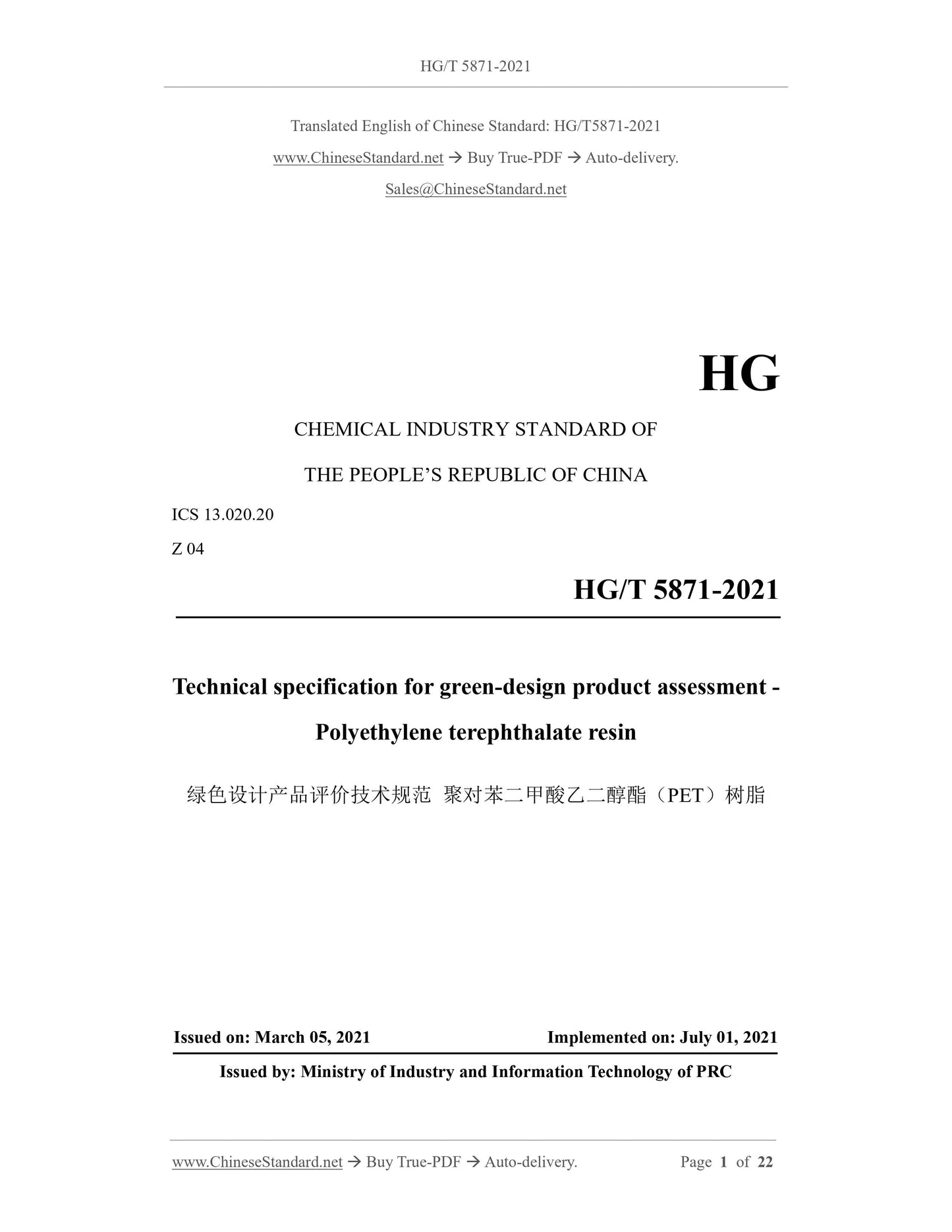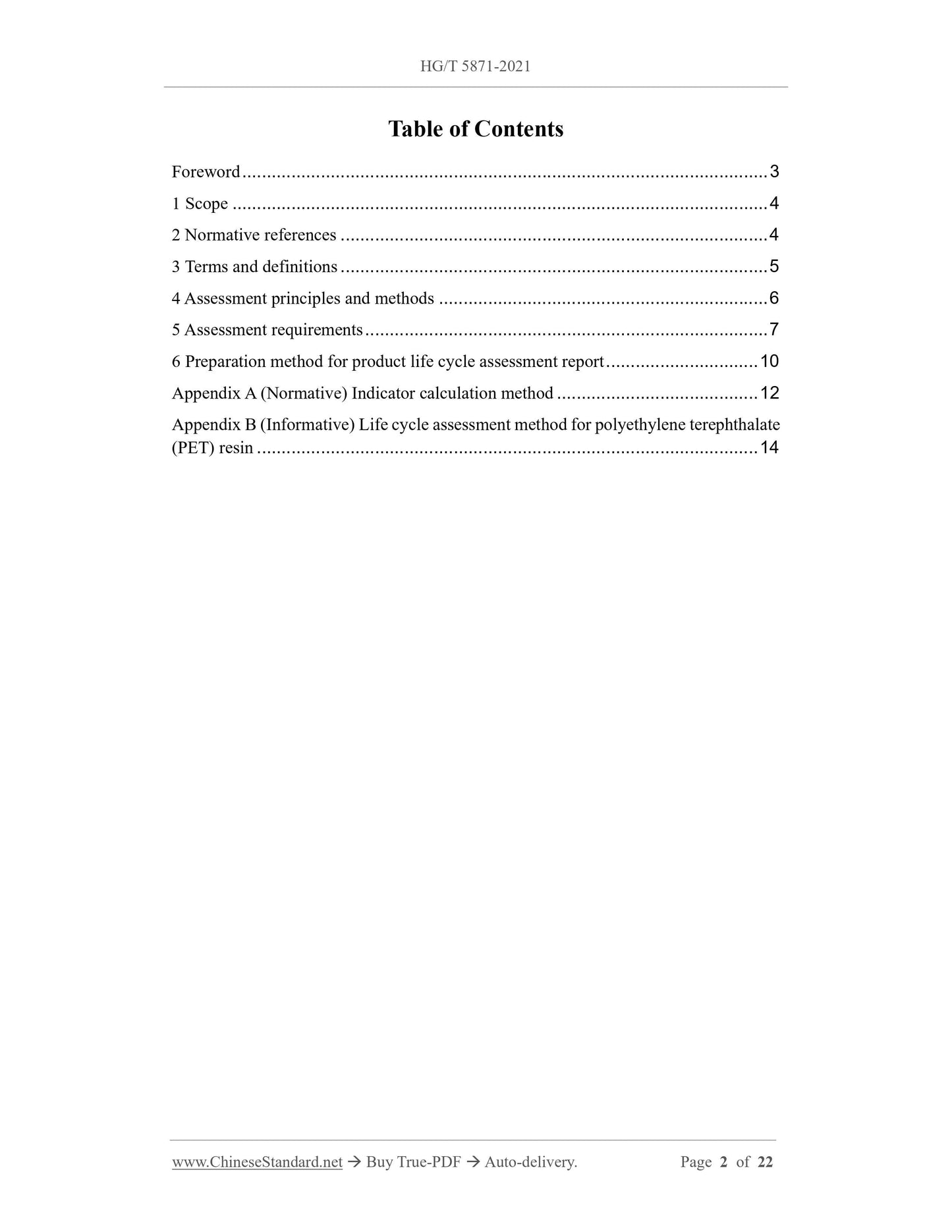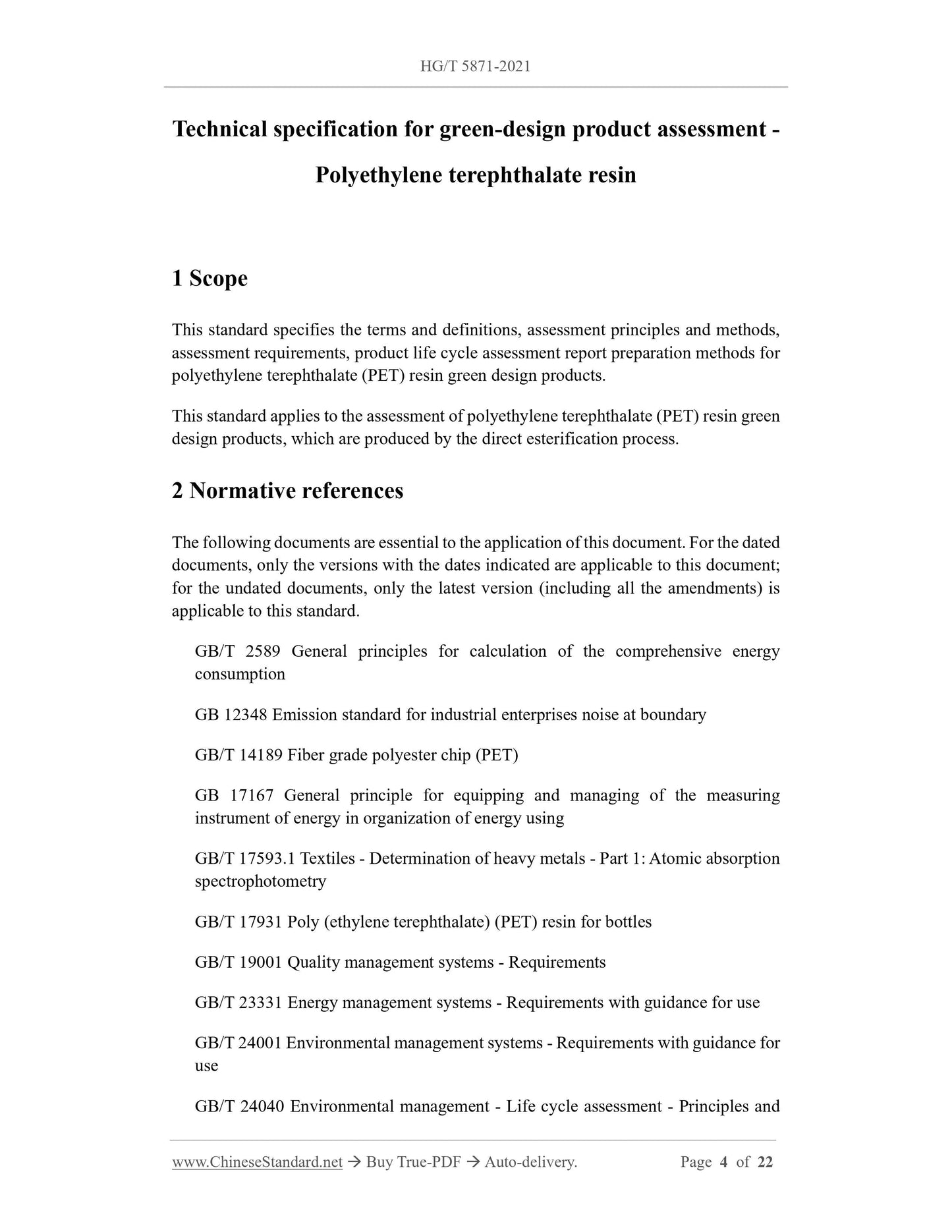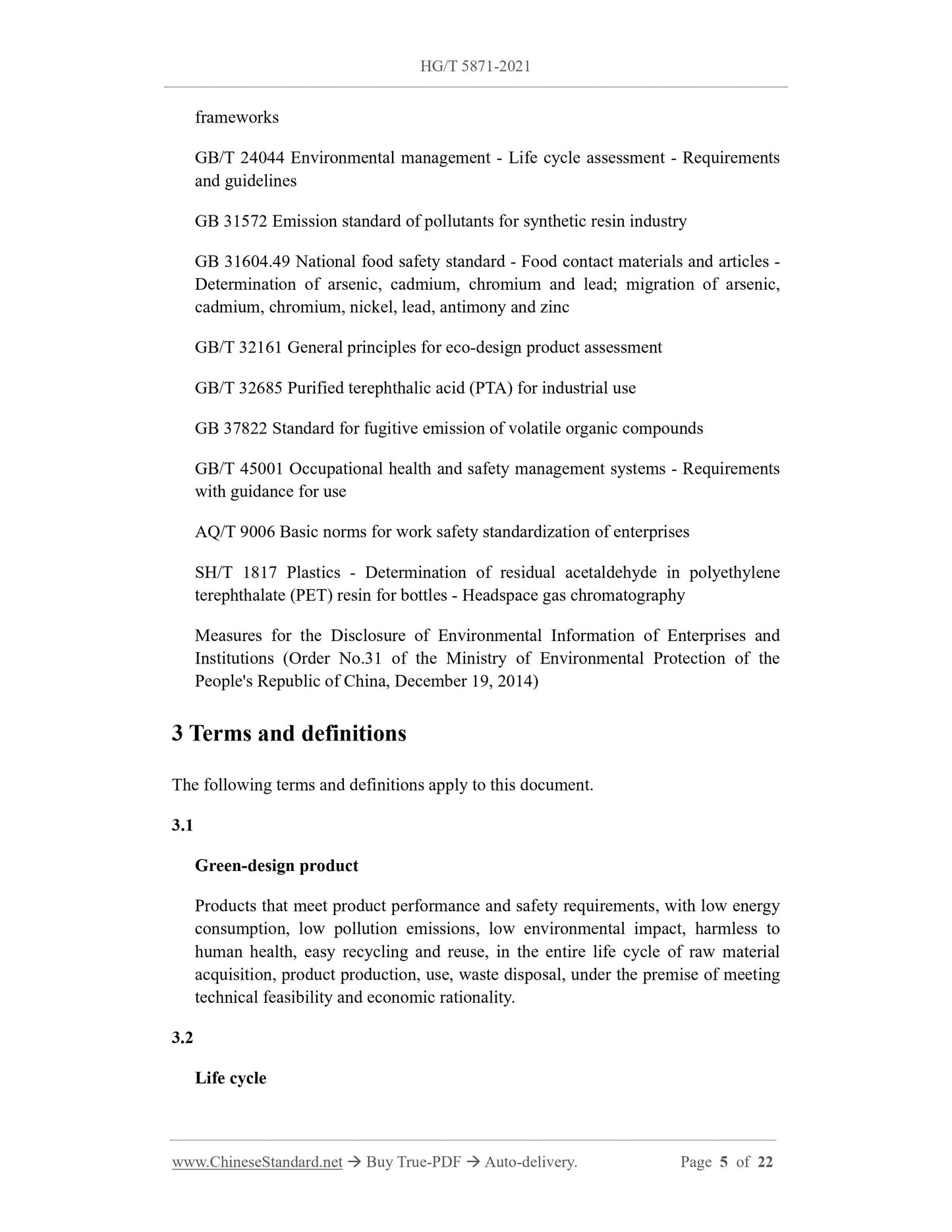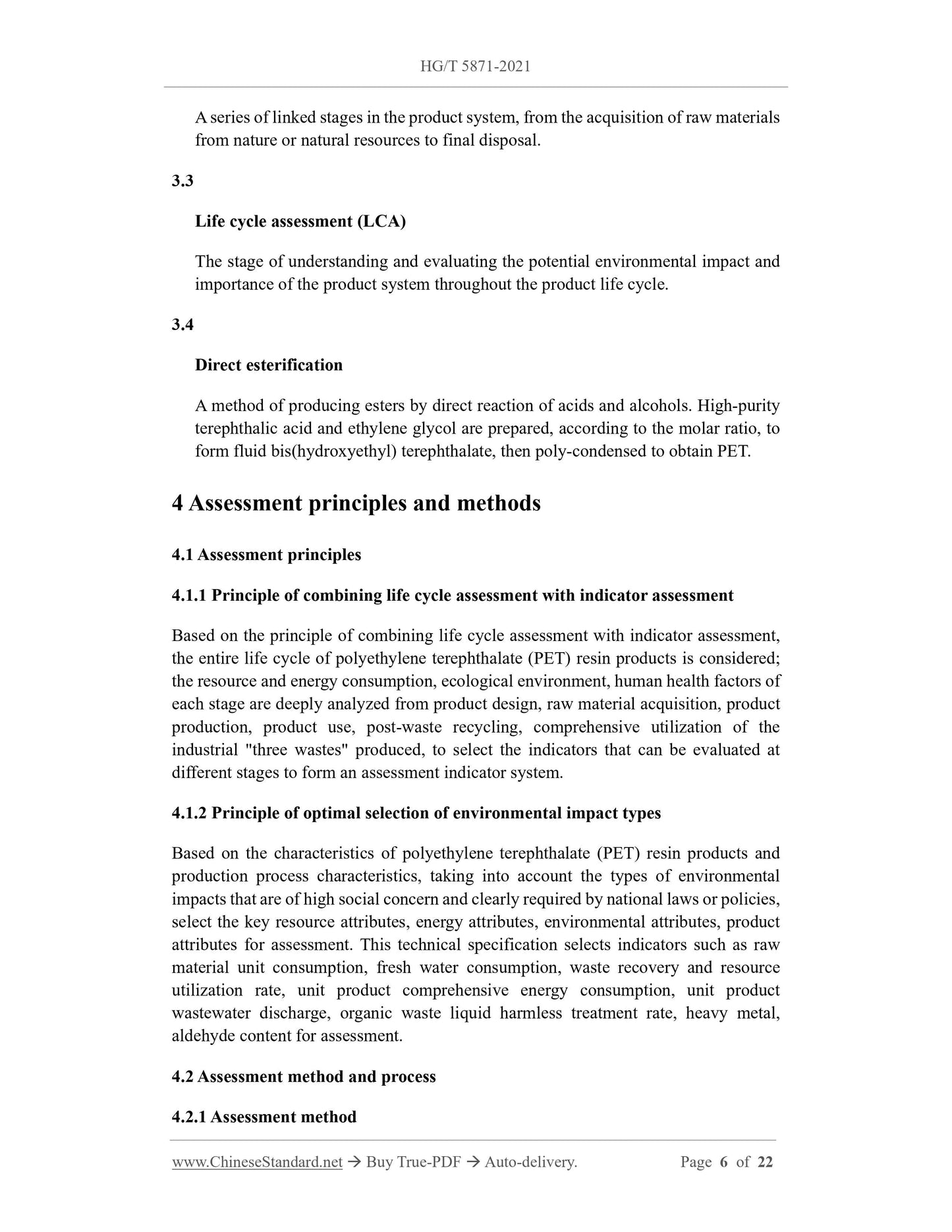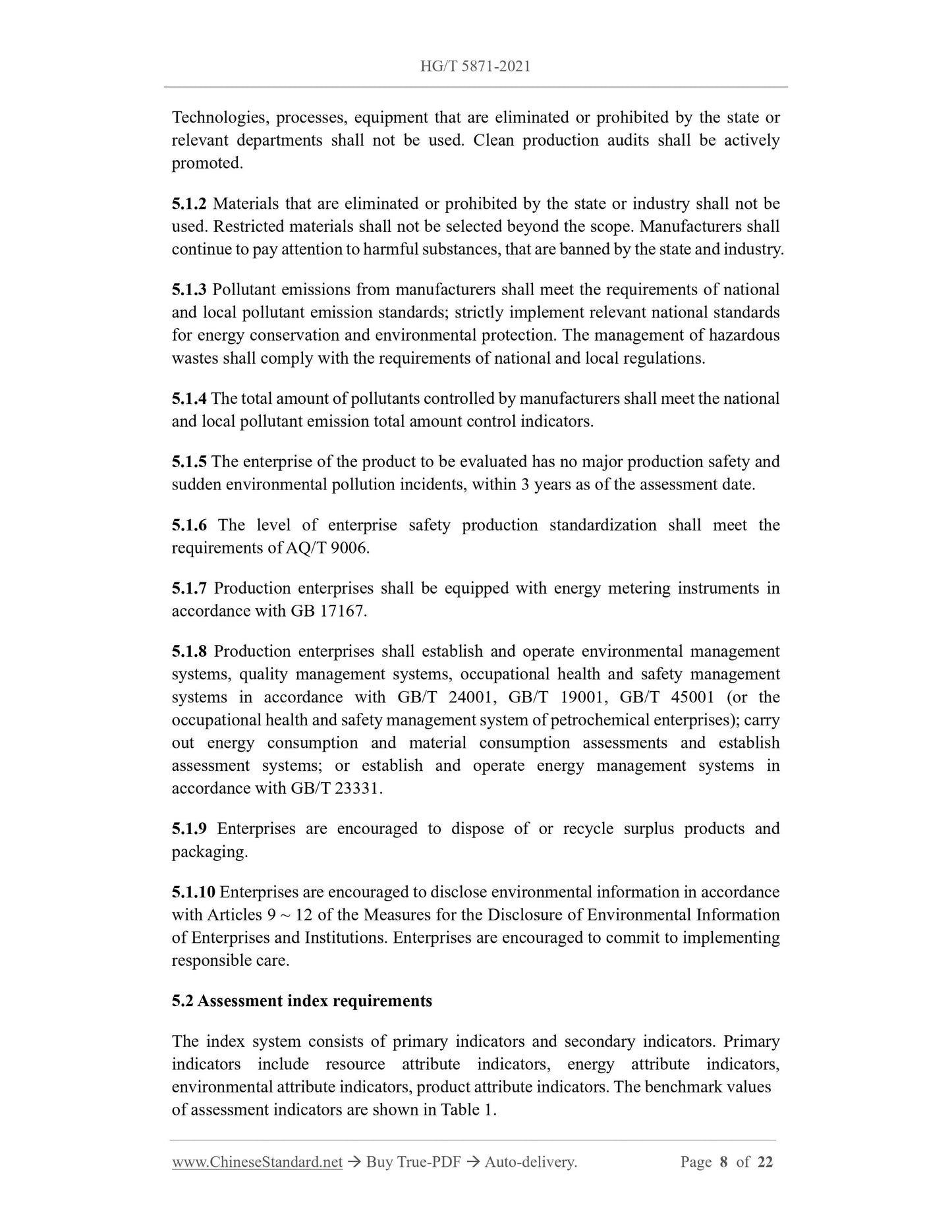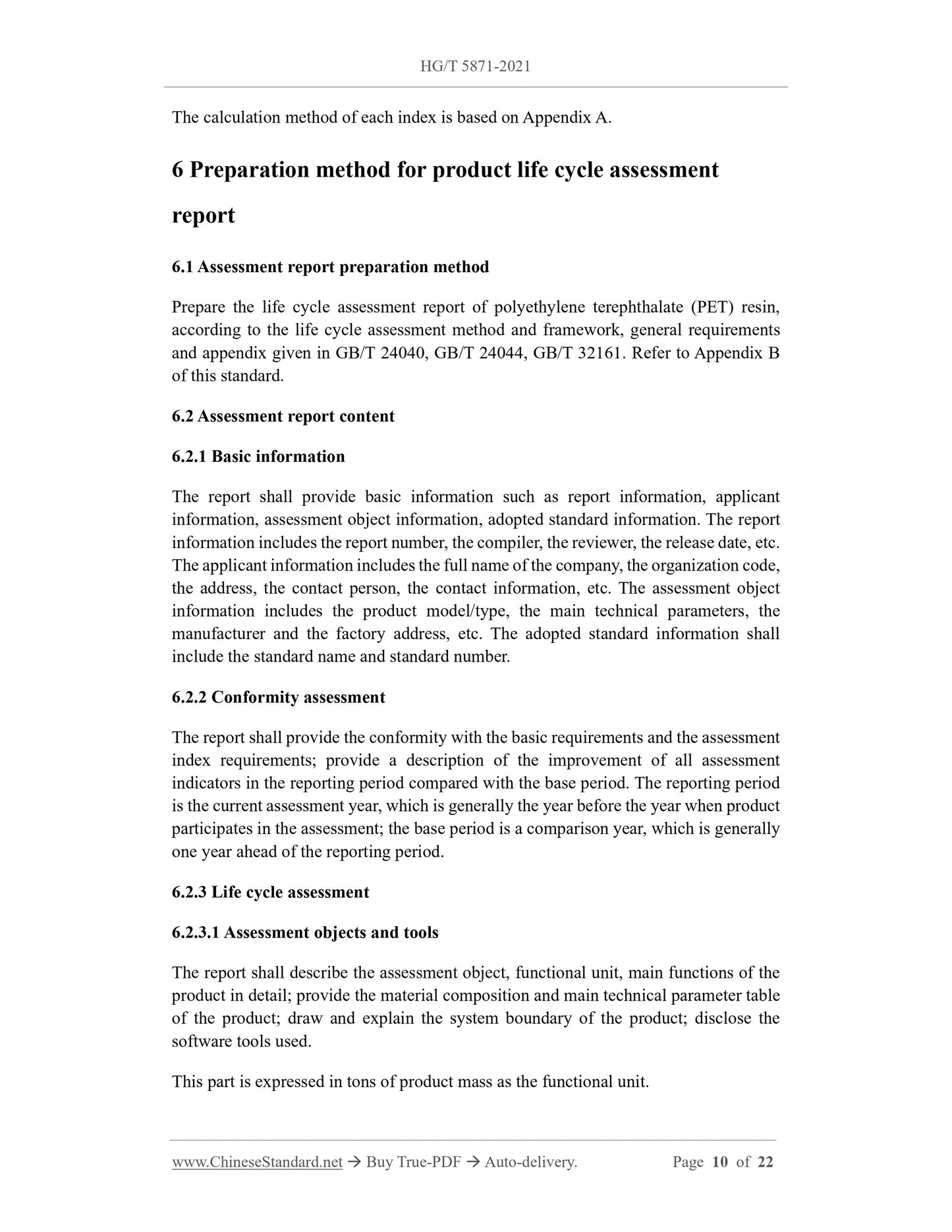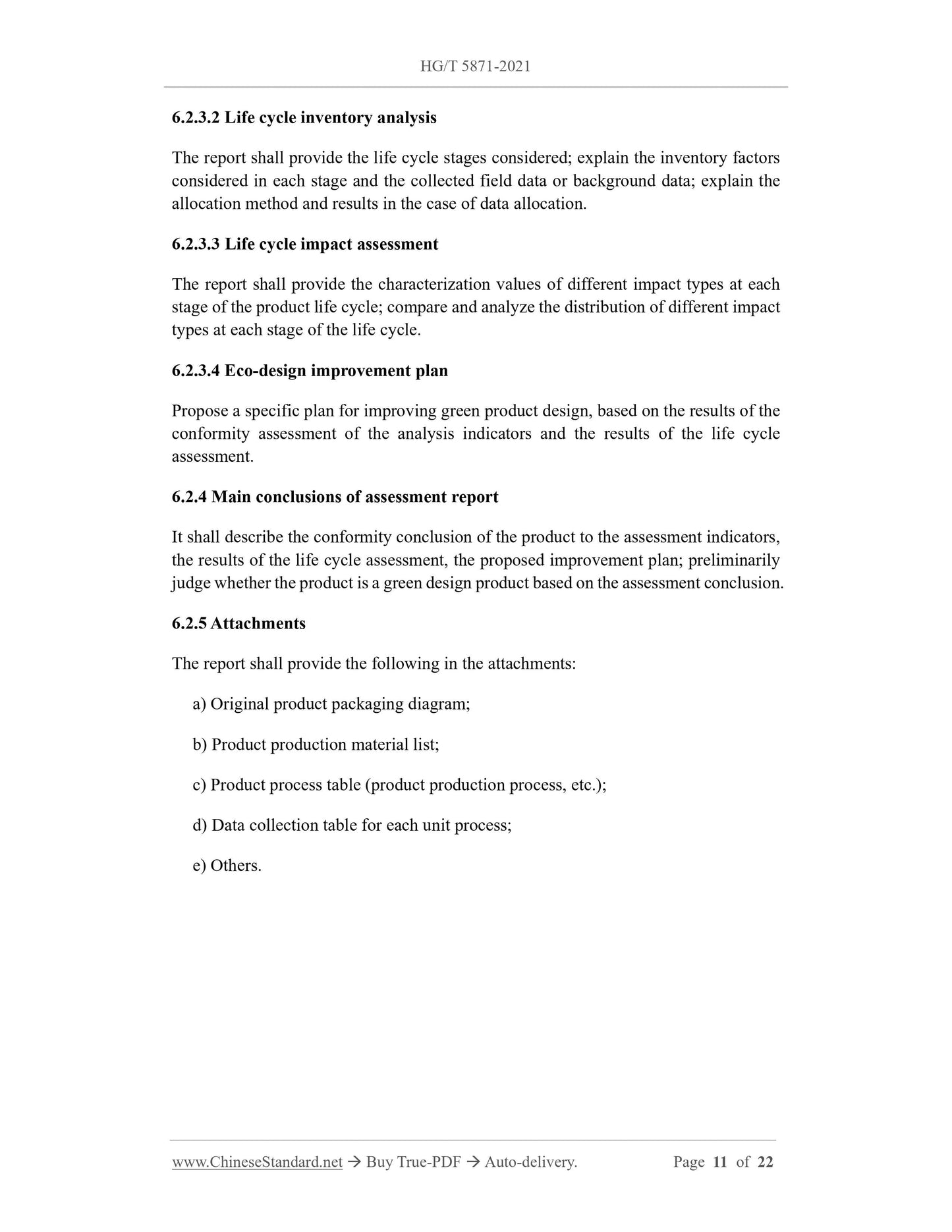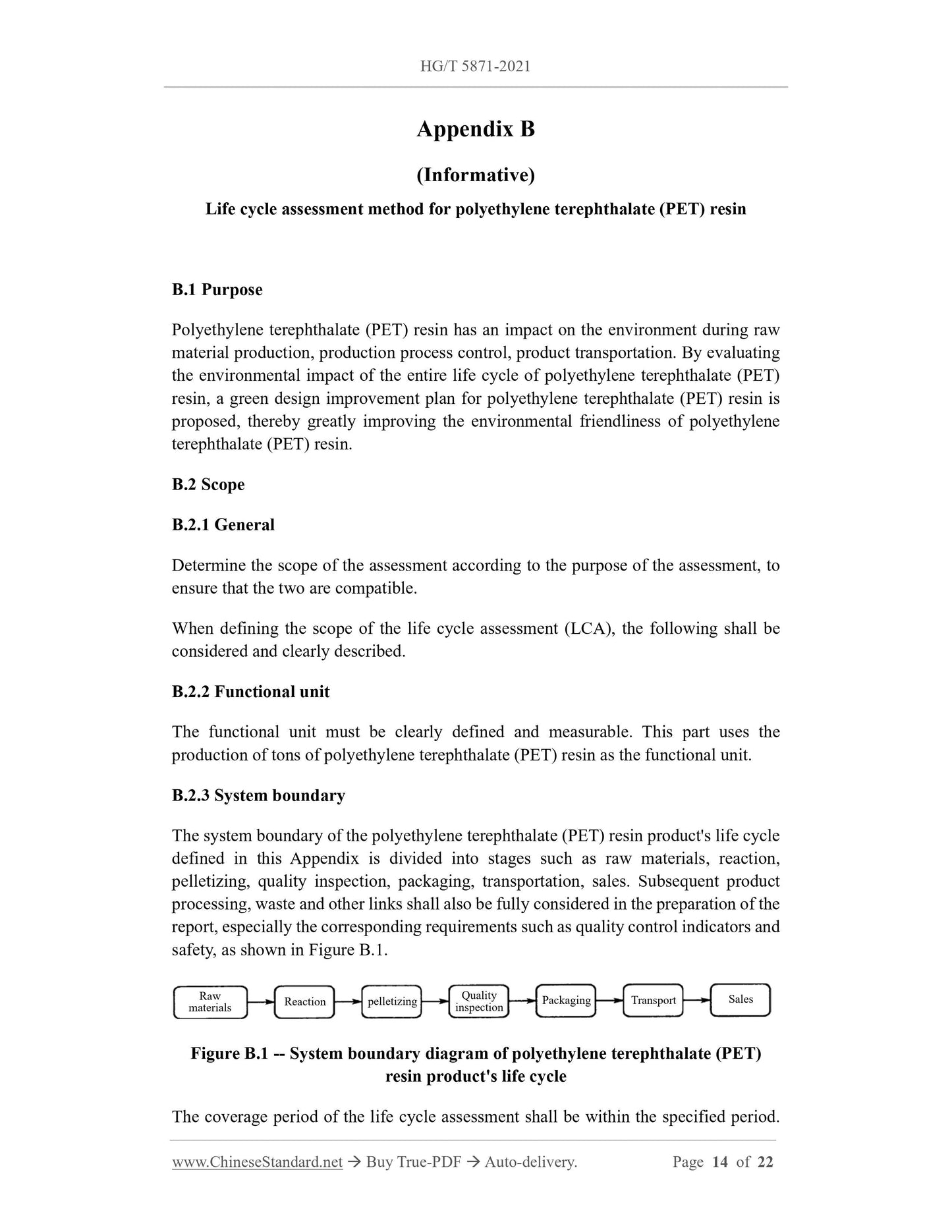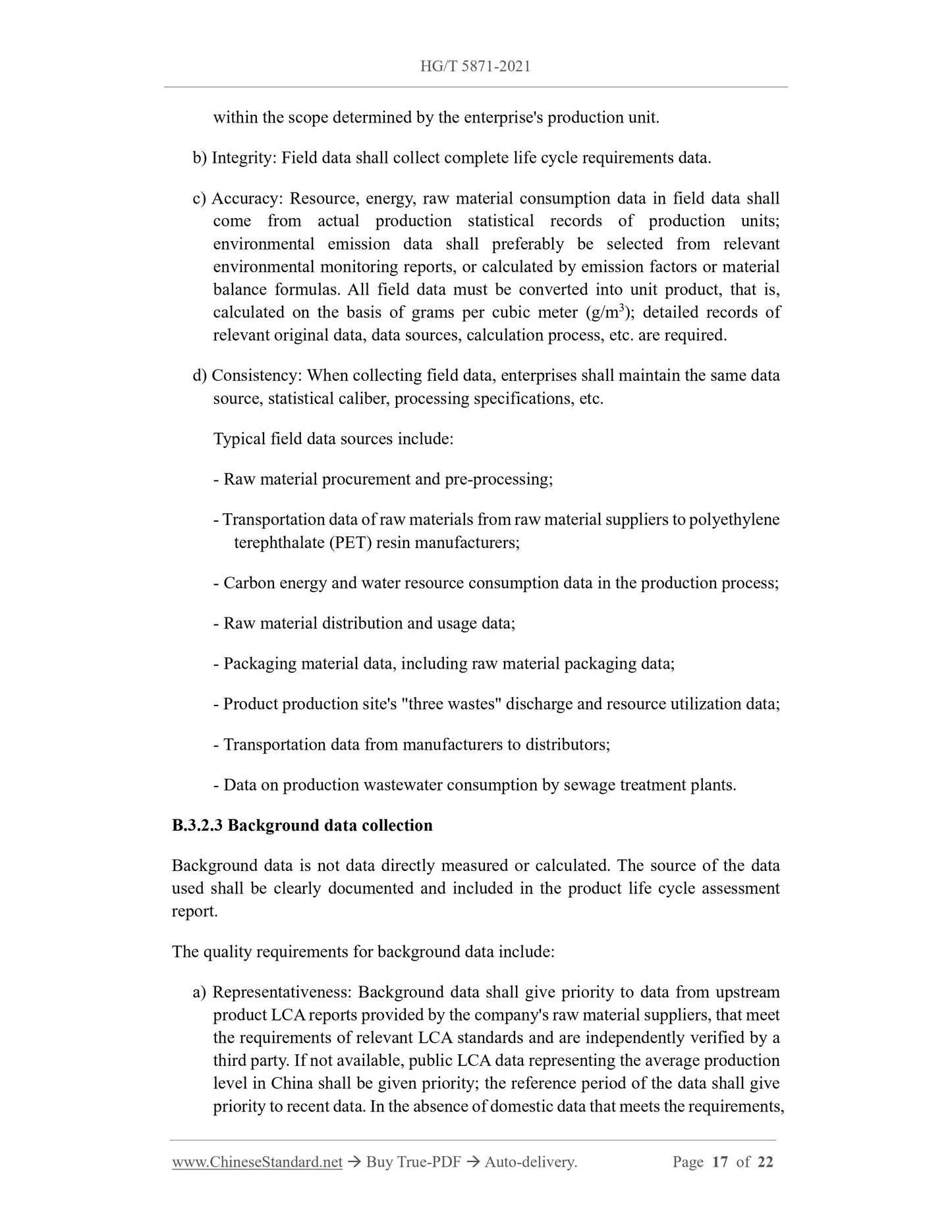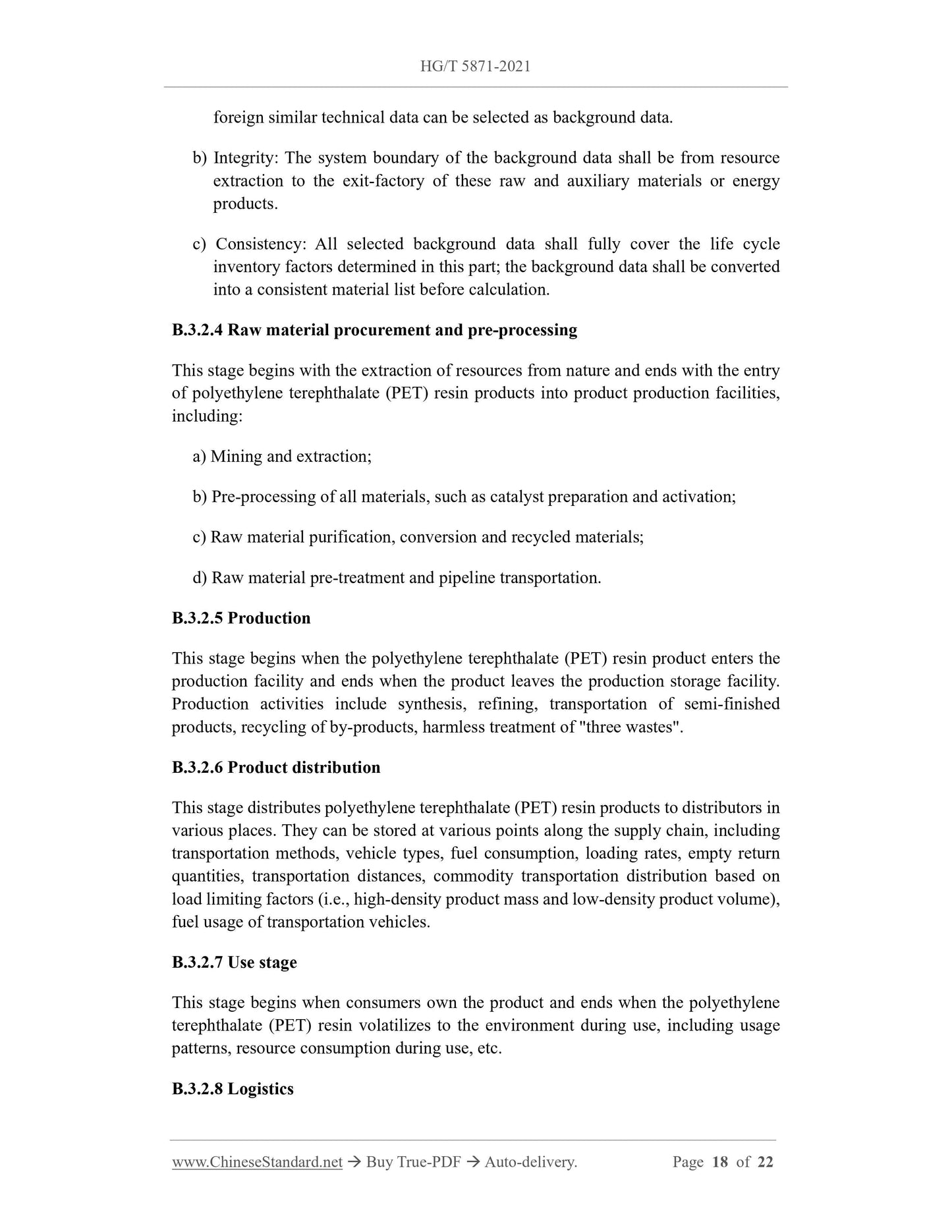1
/
of
12
PayPal, credit cards. Download editable-PDF and invoice in 1 second!
HG/T 5871-2021 English PDF (HGT5871-2021)
HG/T 5871-2021 English PDF (HGT5871-2021)
Regular price
$230.00 USD
Regular price
Sale price
$230.00 USD
Unit price
/
per
Shipping calculated at checkout.
Couldn't load pickup availability
Delivery: 3 seconds. Download true-PDF + Invoice.
Get QUOTATION in 1-minute: Click HG/T 5871-2021
Historical versions: HG/T 5871-2021
Preview True-PDF (Reload/Scroll if blank)
HG/T 5871-2021: Technical specification for green-design product assessment - Polyethylene terephthalate resin
HG/T 5871-2021
HG
CHEMICAL INDUSTRY STANDARD OF
THE PEOPLE’S REPUBLIC OF CHINA
ICS 13.020.20
Z 04
Technical specification for green-design product assessment -
Polyethylene terephthalate resin
ISSUED ON: MARCH 05, 2021
IMPLEMENTED ON: JULY 01, 2021
Issued by: Ministry of Industry and Information Technology of PRC
Table of Contents
Foreword ... 3
1 Scope ... 4
2 Normative references ... 4
3 Terms and definitions ... 5
4 Assessment principles and methods ... 6
5 Assessment requirements ... 7
6 Preparation method for product life cycle assessment report ... 10
Appendix A (Normative) Indicator calculation method ... 12
Appendix B (Informative) Life cycle assessment method for polyethylene terephthalate
(PET) resin ... 14
Technical specification for green-design product assessment -
Polyethylene terephthalate resin
1 Scope
This standard specifies the terms and definitions, assessment principles and methods,
assessment requirements, product life cycle assessment report preparation methods for
polyethylene terephthalate (PET) resin green design products.
This standard applies to the assessment of polyethylene terephthalate (PET) resin green
design products, which are produced by the direct esterification process.
2 Normative references
The following documents are essential to the application of this document. For the dated
documents, only the versions with the dates indicated are applicable to this document;
for the undated documents, only the latest version (including all the amendments) is
applicable to this standard.
GB/T 2589 General principles for calculation of the comprehensive energy
consumption
GB 12348 Emission standard for industrial enterprises noise at boundary
GB/T 14189 Fiber grade polyester chip (PET)
GB 17167 General principle for equipping and managing of the measuring
instrument of energy in organization of energy using
GB/T 17593.1 Textiles - Determination of heavy metals - Part 1: Atomic absorption
spectrophotometry
GB/T 17931 Poly (ethylene terephthalate) (PET) resin for bottles
GB/T 19001 Quality management systems - Requirements
GB/T 23331 Energy management systems - Requirements with guidance for use
GB/T 24001 Environmental management systems - Requirements with guidance for
use
GB/T 24040 Environmental management - Life cycle assessment - Principles and
frameworks
GB/T 24044 Environmental management - Life cycle assessment - Requirements
and guidelines
GB 31572 Emission standard of pollutants for synthetic resin industry
GB 31604.49 National food safety standard - Food contact materials and articles -
Determination of arsenic, cadmium, chromium and lead; migration of arsenic,
cadmium, chromium, nickel, lead, antimony and zinc
GB/T 32161 General principles for eco-design product assessment
GB/T 32685 Purified terephthalic acid (PTA) for industrial use
GB 37822 Standard for fugitive emission of volatile organic compounds
GB/T 45001 Occupational health and safety management systems - Requirements
with guidance for use
AQ/T 9006 Basic norms for work safety standardization of enterprises
SH/T 1817 Plastics - Determination of residual acetaldehyde in polyethylene
terephthalate (PET) resin for bottles - Headspace gas chromatography
Measures for the Disclosure of Environmental Information of Enterprises and
Institutions (Order No.31 of the Ministry of Environmental Protection of the
People's Republic of China, December 19, 2014)
3 Terms and definitions
The following terms and definitions apply to this document.
3.1
Green-design product
Products that meet product performance and safety requirements, with low energy
consumption, low pollution emissions, low environmental impact, harmless to
human health, easy recycling and reuse, in the entire life cycle of raw material
acquisition, product production, use, waste disposal, under the premise of meeting
technical feasibility and economic rationality.
3.2
Life cycle
A series of linked stages in the product system, from the acquisition of raw materials
from nature or natural resources to final disposal.
3.3
Life cycle assessment (LCA)
The stage of understanding and evaluating the potential environmental impact and
importance of the product system throughout the product life cycle.
3.4
Direct esterification
A method of producing esters by direct reaction of acids and alcohols. High-purity
terephthalic acid and ethylene glycol are prepared, according to the molar ratio, to
form fluid bis(hydroxyethyl) terephthalate, then poly-condensed to obtain PET.
4 Assessment principles and methods
4.1 Assessment principles
4.1.1 Principle of combining life cycle assessment with indicator assessment
Based on the principle of combining life cycle assessment with indicator assessment,
the entire life cycle of polyethylene terephthalate (PET) resin products is considered;
the resource and energy consumption, ecological environment, human health factors of
each stage are deeply analyzed from product design, raw material acquisition, product
production, product use, post-waste recycling, comprehensive utilization of the
industrial "three wastes" produced, to select the indicators that can be evaluated at
different stages to form an assessment indicator system.
4.1.2 Principle of optimal selection of environmental impact types
Based on the characteristics of polyethylene terephthalate (PET) resin products and
production process characteristics, taking into account the types of environmental
impacts that are of high social concern and clearly required by national laws or policies,
select the key resource attributes, energy attributes, environmental attributes, product
attributes for assessment. This technical specification selects indicators such as raw
material unit consumption, fresh water consumption, waste recovery and resource
utilization rate, unit product comprehensive energy consumption, unit product
wastewater discharge, organic waste liquid harmless treatment rate, heavy metal,
aldehyde content for assessment.
4.2 Assessment method and process
4.2.1 Assessment method
Technologies, processes, equipment that are eliminated or prohibited by the state or
relevant departments shall not be used. Clean production audits shall be actively
promoted.
5.1.2 Materials that are eliminated or prohibited by the state or industry shall not be
used. Restricted materials shall not be selected beyond the scope. Manufacturers shall
continue to pay attention to harmful substances, that are banned by the state and industry.
5.1.3 Pollutant emissions from manufacturers shall meet the requirements of national
and local pollutant emission standards; strictly implement relevant national standards
for energy conservation and environmental protection. The management of hazardous
wastes shall comply with the requirements of national and local regulations.
5.1.4 The total amount of pollutants controlled by manufacturers shall meet the national
and local pollutant emission total amount control indicators.
5.1.5 The enterprise of the product to be evaluated has no major production safety and
sudden environmental pollution incidents, within 3 years as of the assessment date.
5.1.6 The level of enterprise safety production standardization shall meet the
requirements of AQ/T 9006.
5.1.7 Production enterprises shall be equipped with energy metering instruments in
accordance with GB 17167.
5.1.8 Production e...
Get QUOTATION in 1-minute: Click HG/T 5871-2021
Historical versions: HG/T 5871-2021
Preview True-PDF (Reload/Scroll if blank)
HG/T 5871-2021: Technical specification for green-design product assessment - Polyethylene terephthalate resin
HG/T 5871-2021
HG
CHEMICAL INDUSTRY STANDARD OF
THE PEOPLE’S REPUBLIC OF CHINA
ICS 13.020.20
Z 04
Technical specification for green-design product assessment -
Polyethylene terephthalate resin
ISSUED ON: MARCH 05, 2021
IMPLEMENTED ON: JULY 01, 2021
Issued by: Ministry of Industry and Information Technology of PRC
Table of Contents
Foreword ... 3
1 Scope ... 4
2 Normative references ... 4
3 Terms and definitions ... 5
4 Assessment principles and methods ... 6
5 Assessment requirements ... 7
6 Preparation method for product life cycle assessment report ... 10
Appendix A (Normative) Indicator calculation method ... 12
Appendix B (Informative) Life cycle assessment method for polyethylene terephthalate
(PET) resin ... 14
Technical specification for green-design product assessment -
Polyethylene terephthalate resin
1 Scope
This standard specifies the terms and definitions, assessment principles and methods,
assessment requirements, product life cycle assessment report preparation methods for
polyethylene terephthalate (PET) resin green design products.
This standard applies to the assessment of polyethylene terephthalate (PET) resin green
design products, which are produced by the direct esterification process.
2 Normative references
The following documents are essential to the application of this document. For the dated
documents, only the versions with the dates indicated are applicable to this document;
for the undated documents, only the latest version (including all the amendments) is
applicable to this standard.
GB/T 2589 General principles for calculation of the comprehensive energy
consumption
GB 12348 Emission standard for industrial enterprises noise at boundary
GB/T 14189 Fiber grade polyester chip (PET)
GB 17167 General principle for equipping and managing of the measuring
instrument of energy in organization of energy using
GB/T 17593.1 Textiles - Determination of heavy metals - Part 1: Atomic absorption
spectrophotometry
GB/T 17931 Poly (ethylene terephthalate) (PET) resin for bottles
GB/T 19001 Quality management systems - Requirements
GB/T 23331 Energy management systems - Requirements with guidance for use
GB/T 24001 Environmental management systems - Requirements with guidance for
use
GB/T 24040 Environmental management - Life cycle assessment - Principles and
frameworks
GB/T 24044 Environmental management - Life cycle assessment - Requirements
and guidelines
GB 31572 Emission standard of pollutants for synthetic resin industry
GB 31604.49 National food safety standard - Food contact materials and articles -
Determination of arsenic, cadmium, chromium and lead; migration of arsenic,
cadmium, chromium, nickel, lead, antimony and zinc
GB/T 32161 General principles for eco-design product assessment
GB/T 32685 Purified terephthalic acid (PTA) for industrial use
GB 37822 Standard for fugitive emission of volatile organic compounds
GB/T 45001 Occupational health and safety management systems - Requirements
with guidance for use
AQ/T 9006 Basic norms for work safety standardization of enterprises
SH/T 1817 Plastics - Determination of residual acetaldehyde in polyethylene
terephthalate (PET) resin for bottles - Headspace gas chromatography
Measures for the Disclosure of Environmental Information of Enterprises and
Institutions (Order No.31 of the Ministry of Environmental Protection of the
People's Republic of China, December 19, 2014)
3 Terms and definitions
The following terms and definitions apply to this document.
3.1
Green-design product
Products that meet product performance and safety requirements, with low energy
consumption, low pollution emissions, low environmental impact, harmless to
human health, easy recycling and reuse, in the entire life cycle of raw material
acquisition, product production, use, waste disposal, under the premise of meeting
technical feasibility and economic rationality.
3.2
Life cycle
A series of linked stages in the product system, from the acquisition of raw materials
from nature or natural resources to final disposal.
3.3
Life cycle assessment (LCA)
The stage of understanding and evaluating the potential environmental impact and
importance of the product system throughout the product life cycle.
3.4
Direct esterification
A method of producing esters by direct reaction of acids and alcohols. High-purity
terephthalic acid and ethylene glycol are prepared, according to the molar ratio, to
form fluid bis(hydroxyethyl) terephthalate, then poly-condensed to obtain PET.
4 Assessment principles and methods
4.1 Assessment principles
4.1.1 Principle of combining life cycle assessment with indicator assessment
Based on the principle of combining life cycle assessment with indicator assessment,
the entire life cycle of polyethylene terephthalate (PET) resin products is considered;
the resource and energy consumption, ecological environment, human health factors of
each stage are deeply analyzed from product design, raw material acquisition, product
production, product use, post-waste recycling, comprehensive utilization of the
industrial "three wastes" produced, to select the indicators that can be evaluated at
different stages to form an assessment indicator system.
4.1.2 Principle of optimal selection of environmental impact types
Based on the characteristics of polyethylene terephthalate (PET) resin products and
production process characteristics, taking into account the types of environmental
impacts that are of high social concern and clearly required by national laws or policies,
select the key resource attributes, energy attributes, environmental attributes, product
attributes for assessment. This technical specification selects indicators such as raw
material unit consumption, fresh water consumption, waste recovery and resource
utilization rate, unit product comprehensive energy consumption, unit product
wastewater discharge, organic waste liquid harmless treatment rate, heavy metal,
aldehyde content for assessment.
4.2 Assessment method and process
4.2.1 Assessment method
Technologies, processes, equipment that are eliminated or prohibited by the state or
relevant departments shall not be used. Clean production audits shall be actively
promoted.
5.1.2 Materials that are eliminated or prohibited by the state or industry shall not be
used. Restricted materials shall not be selected beyond the scope. Manufacturers shall
continue to pay attention to harmful substances, that are banned by the state and industry.
5.1.3 Pollutant emissions from manufacturers shall meet the requirements of national
and local pollutant emission standards; strictly implement relevant national standards
for energy conservation and environmental protection. The management of hazardous
wastes shall comply with the requirements of national and local regulations.
5.1.4 The total amount of pollutants controlled by manufacturers shall meet the national
and local pollutant emission total amount control indicators.
5.1.5 The enterprise of the product to be evaluated has no major production safety and
sudden environmental pollution incidents, within 3 years as of the assessment date.
5.1.6 The level of enterprise safety production standardization shall meet the
requirements of AQ/T 9006.
5.1.7 Production enterprises shall be equipped with energy metering instruments in
accordance with GB 17167.
5.1.8 Production e...
Share
